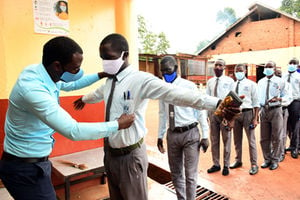Prime
Relationship between speed and road crashes

The World Health Organisation estimates that Uganda loses 29 people per 100,000 to road crashes annually, a figure that is much higher than the global average of 18 people per 100,000. Photo/ file
What you need to know:
Speeding increases the likelihood that a driver will lose control of the vehicle since there is less time to anticipate oncoming hazards. It also causes others using the road to misjudge the intentions of the speeding driver.
Globally, five major risk factors including drink-driving, not using helmets, speeding, ignoring the use of seat belts and child restraints cause road crashes. Speed, however, is the most dangerous.
The World Health Organisation (WHO) estimates that Uganda loses 29 people per 100,000 to road crashes annually, a figure that is much higher than the global average of 18 people per 100,000. Apart from motorcyclists, the most vulnerable road users are sadly not even in control of the vehicles that kill or seriously injure them.
Dangers of speeding
Research from WHO shows that every one percent increase in average speed leads to a four percent increase in the fatal crash risk and a three percent increase in the risk of a serious crash. If, for instance you are driving at 120km/hr and you are involved in a head-on collision, your body will be ejected from the car through the windscreen at 120km/hr, which will lead to instant death.
Similarly, a five percent reduction in average speed can reduce the number of fatalities by 30 percent.
Cars and fatal crashes
Recent data collected by the Bloomberg Philanthropies Initiative for Global Road Safety (BIGRS) and Kampala Capital City Authority (KCCA) surveillance team from 2018 to 2021 shows that sport utility vehicles (SUVs) and saloon cars kill more road users. The data also states that fatal crashes are higher between 4pm and 8pm, the evening rush hours when people are leaving work.
Obtained from nine major police stations from Kampala’s five divisions, the data was from the second Kampala City road safety report whose aim was to provide continuous and ongoing reporting of the city’s road safety situation, and to plan and evaluate planned and ongoing interventions.
Stellah Namatovu, the BIGRS-KCCA surveillance coordinator says Sundays and Saturdays accounted for the highest number of reported deaths. This is attributed to fewer cars on the road, where motorists speed more, thereby increasing the risk of fatal crashes. This trend has been consistent since 2018.
Responsibility
Rogers Kauma Nsereko, the traffic commandant of Kampala Metropolitan Area, says the biggest number of people who work in the city centre are pedestrians who predominantly walk to and from the city centre.
“As a pedestrian, it is safer to walk on the side of oncoming vehicles so that in case of say a vehicle experiencing brake failure or one driving carelessly, you can escape to safety,” Nsereko advises.
According to previous police crime reports, another category of road users vulnerable to crashes are those who use boda bodas. Because motorcyclists speed and abuse road and traffic rules, including riding through red traffic lights, they end up putting your life in danger.
“Do not delegate road safety to authorities such as police or government because we cannot be everywhere all the time. If you board a motorcycle and the rider wants to use one side of oncoming vehicles or go past traffic lights and junction boxes, ask them to stop,” Nsereko cautions.
If you are a daily or regular motorcycle passenger, it is recommended to own a helmet. A strong helmet costs between Shs120,000 to Shs200,000, depending on where you buy it from. Helmets, Nsereko emphasises, reduce the risk of death by protecting your head in case of a boda boda crash.
Penalties
Recently, Parliament passed the Traffic and Road Safety (Amendment) Act, 2023 to return the regulation and management of speed to the Traffic and Road Safety Act, 1998. The Act prescribed a fine not exceeding 100 currency points (one currency point is equivalent to Shs20,000) or imprisonment not exceeding three years, or both as the penalty if you are convicted of the offence of driving beyond the prescribed limit.
Recently, the President Museveni signed the Act into law. When you are caught driving beyond the recommended speed, you will be charged the highest penalty of Shs2m. This is aimed at curbing repeat offenders and improving driver behaviour among road users and to develop a safety culture which will protect most vulnerable road users, especially pedestrians and passengers.
“The law has come at the right time because it is a means of reducing traffic crashes deaths caused by repetitive offenders. Roads are a public good and should be enjoyed and made safe for everyone to use at all times,” says Hannah Muzee, the associate director at Centre for Policy Analysis.
Black spots
Data shows that the highest fatal crash corridors include Entebbe Road from Kibuye to Najjanankumbi, Kisaasi to Naalya roundabout, Busega to Namungona roundabout, Gayaza roundabout to Kyebando Police Station and Ggaba Road.
Data also shows that pedestrian fatal corridors include Bombo Road from Wandegeya, Kampala Road and Jinja Road from Nakawa traffic lights, Clock Tower to Najjanankumbi corridor and Masaka Road from Busega Roundabout to Nateete at the traffic lights.




